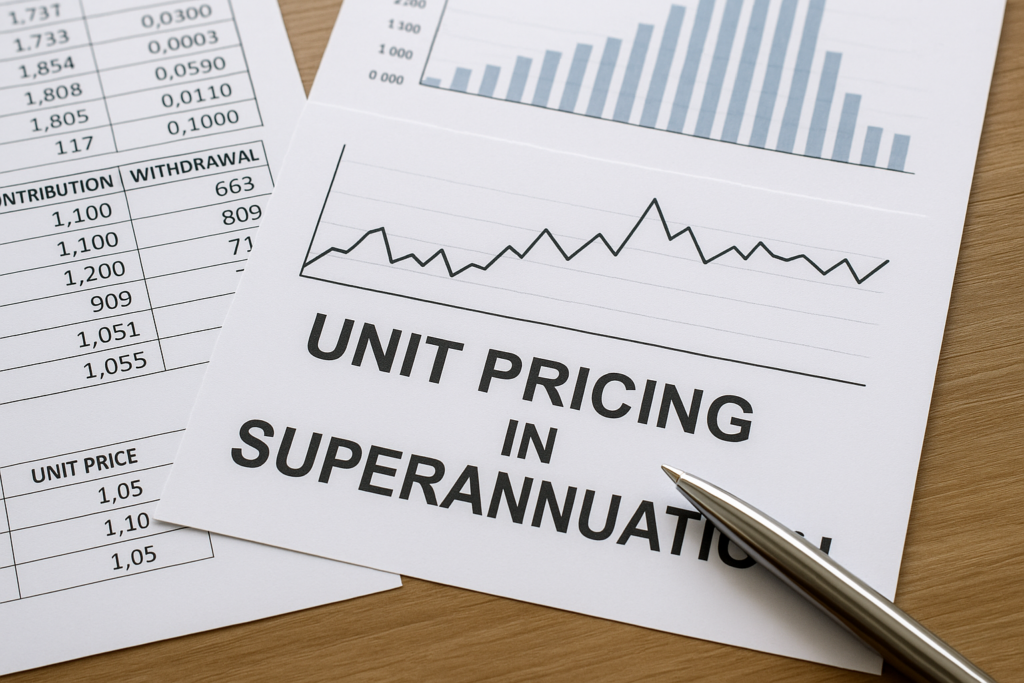Understanding how unit pricing works is crucial for any superannuation member, as it directly impacts the value of your retirement savings.
Understanding Unit Pricing in Superannuation Funds
If you have a superannuation fund in Australia, you may have noticed fluctuations in your super balance, even when there have been no recent contributions, withdrawals, or changes in fees.
These fluctuations are primarily due to the way super funds calculate the performance of your investments.
The two most common methods that super funds use to allocate investment earnings are unit pricing and crediting rates.
While industry super funds have traditionally relied on crediting rates, most funds now use unit pricing, as it operates similarly to buying and selling shares in a company.
Understanding how unit pricing works is crucial for any superannuation member, as it directly impacts the value of your retirement savings.
What is Unit Pricing?
Unit pricing is a system that super funds use to allocate investment earnings. Each investment option within your super fund is divided into units, and the value of each unit fluctuates based on the performance of the underlying assets.
The number of units you own in a particular investment option determines the value of your super balance.
When you make a contribution to your super fund, you are effectively purchasing units in your chosen investment option at the prevailing unit price for that day. Conversely, when money is withdrawn for fees, insurance premiums, or a switch between investment options, units are sold at the unit price on the day the transaction is processed.
The value of the units is based on the Net Asset Value (NAV) of the assets held in the fund. If the value of the assets increases, the unit price will rise. If the value decreases, the unit price will fall.
As such, your super balance will change in response to market fluctuations, even if you haven’t made any new contributions or withdrawals.

How Unit Pricing Affects Your Super Balance
Unit pricing is directly tied to the performance of your super fund’s investments. If the investments held by your fund are performing well, the unit price will rise, and your super balance will increase. On the other hand, if the market experiences a downturn or the value of the underlying assets decreases, the unit price will drop, and your balance will decrease accordingly.
It is important to note that unit prices are calculated daily based on the closing market prices of the fund’s assets. Therefore, your online super balance may not reflect the real-time value of your account, and may be up to a day behind.
This is particularly important when switching between investment options or making a withdrawal, as the unit price used for these transactions will be based on the day the transaction is processed, not the day you request it.
The Buy and Sell Price in Unit Pricing
Some super funds apply different prices for buying and selling units. This is known as the buy/sell spread, and it can affect the value of your balance, especially if you’re making a withdrawal or switching investment options.
- Buy Price: This is the price you pay when you make a contribution to your super fund.
It is typically higher than the sell price because it includes transaction costs such as the cost of buying assets within the fund. - Sell Price: This is the price applied when units are sold, such as when you make a withdrawal or switch investment options.
The sell price is typically lower than the buy price, and the difference between the two prices covers the costs associated with selling assets in the fund.
For instance, if you make a contribution of $1,000, and the buy price is $1.10 per unit, you would purchase approximately 909 units. If you later decide to withdraw your funds and the sell price is $1.05 per unit, you would receive $955 for your 909 units.
The difference between the buy and sell prices, or the buy/sell spread, helps cover the fund’s administrative costs.
Why Your Online Balance May Be Outdated
The unit prices in super funds are typically calculated at the end of each business day. This means that when you check your super balance online, it may not reflect the most current value.
The balance displayed will be based on the unit price from the previous business day, so there could be a delay in showing the actual value of your account.
This delay is especially important to remember when making investment changes.
If you decide to switch investment options, the unit price used will be based on the day your request is processed, not the day you submitted it.
Minimising Costs and Spreads in Super Funds
Some super funds attempt to minimise the costs associated with the buy/sell spread by reallocating units between members rather than selling assets. For example, if the total amount of contributions for the day matches the total withdrawals, the fund may simply reallocate units between members rather than selling assets.
This approach helps to reduce transaction costs and ensures that all members benefit from lower fees.
In some funds, rather than applying a buy/sell spread, the transaction costs are spread across all members of the fund.
These costs are incorporated into the fund’s investment management fees, which are charged as a percentage of the assets under management.
This approach can help reduce costs for members, as it ensures that the fund is not incurring high transaction costs when buying and selling assets.

Understanding Unit Pricing in Your Super Fund
If you are a member of a superannuation fund, it’s important to understand how unit pricing works in order to make informed decisions about your investment options.
Your super balance moves with market performance, just like shares in a stock portfolio, and the number of units you hold depends on the price of those units at the time of purchase.
Some key things to keep in mind when it comes to unit pricing in your super fund are:
- Unit prices fluctuate with market performance: Your super balance will rise or fall based on the underlying assets’ performance.
- You buy and sell units based on the prevailing unit price: When you contribute to or withdraw from your super fund, you are buying or selling units at the unit price of that day.
- The buy/sell spread can affect your balance: Some super funds apply different prices for buying and selling units, which can impact the value of your balance.
- Your online balance may be delayed: Since unit prices are calculated at the end of the day, your online balance may be a day behind.
- Transaction costs are important: Be aware of any fees, including the buy/sell spread and investment management fees, that may impact your balance.
By understanding how unit pricing works, you can have a clearer picture of how your super balance is calculated and what factors can influence its growth.
If you are unsure about how unit pricing works in your super fund, it’s a good idea to speak with a licensed financial adviser or your fund provider for further guidance.
Disclaimer For External Distribution Purposes
The information contained in this publication is for general information purposes only, professional advice should be obtained before acting on any information contained herein. The receiver of this document accepts that this publication may only be distributed for the purposes previously stipulated and agreed upon at subscription. Neither the publishers nor the distributors can accept any responsibility for loss occasioned to any person as a result of action taken or refrained from in consequence of the contents of this publication.
References and Citations:
- Australian Taxation Office (ATO) – Superannuation | www.ato.gov.au
- Financial Planning Association of Australia | www.fpa.com.au
- Superannuation industry resources | www.superannuation.asn.au
Contents

